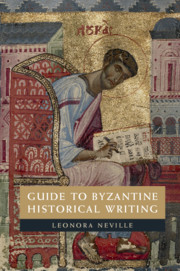Book contents
- Frontmatter
- Dedication
- Contents
- Acknowledgments
- Introduction
- Byzantine Historical Texts
- 1 Theophylakt Simokatta
- 2 Paschal Chronicle
- 3 George Synkellos
- 4 Chronicle of Theophanes
- 5 Patriarch Nikephoros
- 6 Scriptor Incertus de Leo V
- 7 Chronicle of 811
- 8 Megas Chronographos
- 9 George the Monk
- 10 Peter of Alexandria
- 11 Genesios
- 12 Theophanes Continuatus
- 13 Constantinian Excerpts
- 14 John Kaminiates
- 15 Symeon the Logothete
- 16 Leo the Deacon
- 17 Chronicle of Monemvasia
- 18 Chronicon Bruxellense
- 19 Psellos
- 20 John Xiphilinos
- 21 Michael Attaleiates
- 22 John Skylitzes and Scylitzes Continuatus
- 23 George Kedrenos
- 24 Nikephoros Bryennios
- 25 Anna Komnene
- 26 John Kinnamos
- 27 John Zonaras
- 28 Constantine Manasses
- 29 Michael Glykas
- 30 Eustathios of Thessaloniki
- 31 Joel
- 32 Niketas Choniates
- 33 George Akropolites
- 34 Theodore Skoutariotes
- 35 George Pachymeres
- 36 Nikephoros Gregoras
- 37 Ephraim
- 38 Constantine Akropolites the Grand Logothete
- 39 Chronicle of Morea
- 40 Nikephoros Kallistos Xanthopoulos
- 41 John VI Kantakouzenos
- 42 Michael Panaretos
- 43 Chronicle of Ioannina
- 44 Chronicle of Tocco
- 45 John Kananos
- 46 John Anagnostes
- 47 Leontios Machairas
- 48 Sylvester Syropoulos
- 49 Doukas
- 50 George Sphrantzes
- 51 Michael Kritovoulos
- 52 Laonikos Chalkokondyles
- Appendix A Time Periods Covered in the Histories
- Appendix B Timeline of Authors’ Lives
17 - Chronicle of Monemvasia
from Byzantine Historical Texts
Published online by Cambridge University Press: 14 June 2018
- Frontmatter
- Dedication
- Contents
- Acknowledgments
- Introduction
- Byzantine Historical Texts
- 1 Theophylakt Simokatta
- 2 Paschal Chronicle
- 3 George Synkellos
- 4 Chronicle of Theophanes
- 5 Patriarch Nikephoros
- 6 Scriptor Incertus de Leo V
- 7 Chronicle of 811
- 8 Megas Chronographos
- 9 George the Monk
- 10 Peter of Alexandria
- 11 Genesios
- 12 Theophanes Continuatus
- 13 Constantinian Excerpts
- 14 John Kaminiates
- 15 Symeon the Logothete
- 16 Leo the Deacon
- 17 Chronicle of Monemvasia
- 18 Chronicon Bruxellense
- 19 Psellos
- 20 John Xiphilinos
- 21 Michael Attaleiates
- 22 John Skylitzes and Scylitzes Continuatus
- 23 George Kedrenos
- 24 Nikephoros Bryennios
- 25 Anna Komnene
- 26 John Kinnamos
- 27 John Zonaras
- 28 Constantine Manasses
- 29 Michael Glykas
- 30 Eustathios of Thessaloniki
- 31 Joel
- 32 Niketas Choniates
- 33 George Akropolites
- 34 Theodore Skoutariotes
- 35 George Pachymeres
- 36 Nikephoros Gregoras
- 37 Ephraim
- 38 Constantine Akropolites the Grand Logothete
- 39 Chronicle of Morea
- 40 Nikephoros Kallistos Xanthopoulos
- 41 John VI Kantakouzenos
- 42 Michael Panaretos
- 43 Chronicle of Ioannina
- 44 Chronicle of Tocco
- 45 John Kananos
- 46 John Anagnostes
- 47 Leontios Machairas
- 48 Sylvester Syropoulos
- 49 Doukas
- 50 George Sphrantzes
- 51 Michael Kritovoulos
- 52 Laonikos Chalkokondyles
- Appendix A Time Periods Covered in the Histories
- Appendix B Timeline of Authors’ Lives
Summary
This three- page text is “one of the most controversial sources for the history of the Slavs in Greece.” It is a compilation of texts about Avars and the bishopric of Patras, rather than a chronicle. Because it describes the removal of the Greek population of the Peloponnese, it has played a contentious role in debates over the Slavic settlement of Greece in the nineteenth and twentieth centuries. In 1836, Jakob Fallmerayer used the text to argue that the modern inhabitants of Greece descend from Slavs rather than ancient Greeks, with overt prejudicial and political implications. Fallmerayer's thesis sparked a vigorous response from Greek nationalist historians and interpretations of the Chronicle of Monemvasia continued to be highly politicized. Furor has faded as the integration of archaeology into our understanding of history, and the evolution of views on how ethnic communities are constructed, has changed how historians approach the evidence of such brief medieval texts.
The text was found in four manuscripts: Iviron 329 (sixteenth century), Kutlumus 220 (fifteenth or sixteenth century), Taurinensis 336 (sixteenth century), and Collegio Greco 12 (thirteenth/ fifteenth– sixteenth centuries). Taurinensis 336 was destroyed by fire in 1904, but is known through editions by Pasini and Bees. The Kutlumus and Tauriensis manuscripts contain essentially the same version of the text, but there are significant differences among the other manuscripts. The Iviron manuscript was thought to have been the earlier version, but because Kultlumus and Taurinensis use the older Alexandrian dating system, some scholars now believe they derive from the earliest version.
The chronicle has a main narrative, in two parts, describing a) wars between the Romans and the Avars in the sixth century and b) the Avar conquest of the Peleponnese, the flight of indigenous inhabitants, and their return after a reconquest under Nikephoros I. This narrative, most likely originating in the tenth century, is in Iviron 329 and a shorter version of it is in Kultlumus 220 and Taurinesis. A continuation listing information about the bishoprics of the Peloponnese in the eleventh through fourteenth centuries is in Kutlumus, Taurinesis, and Collegio Greco 12.
- Type
- Chapter
- Information
- Guide to Byzantine Historical Writing , pp. 128 - 134Publisher: Cambridge University PressPrint publication year: 2018

